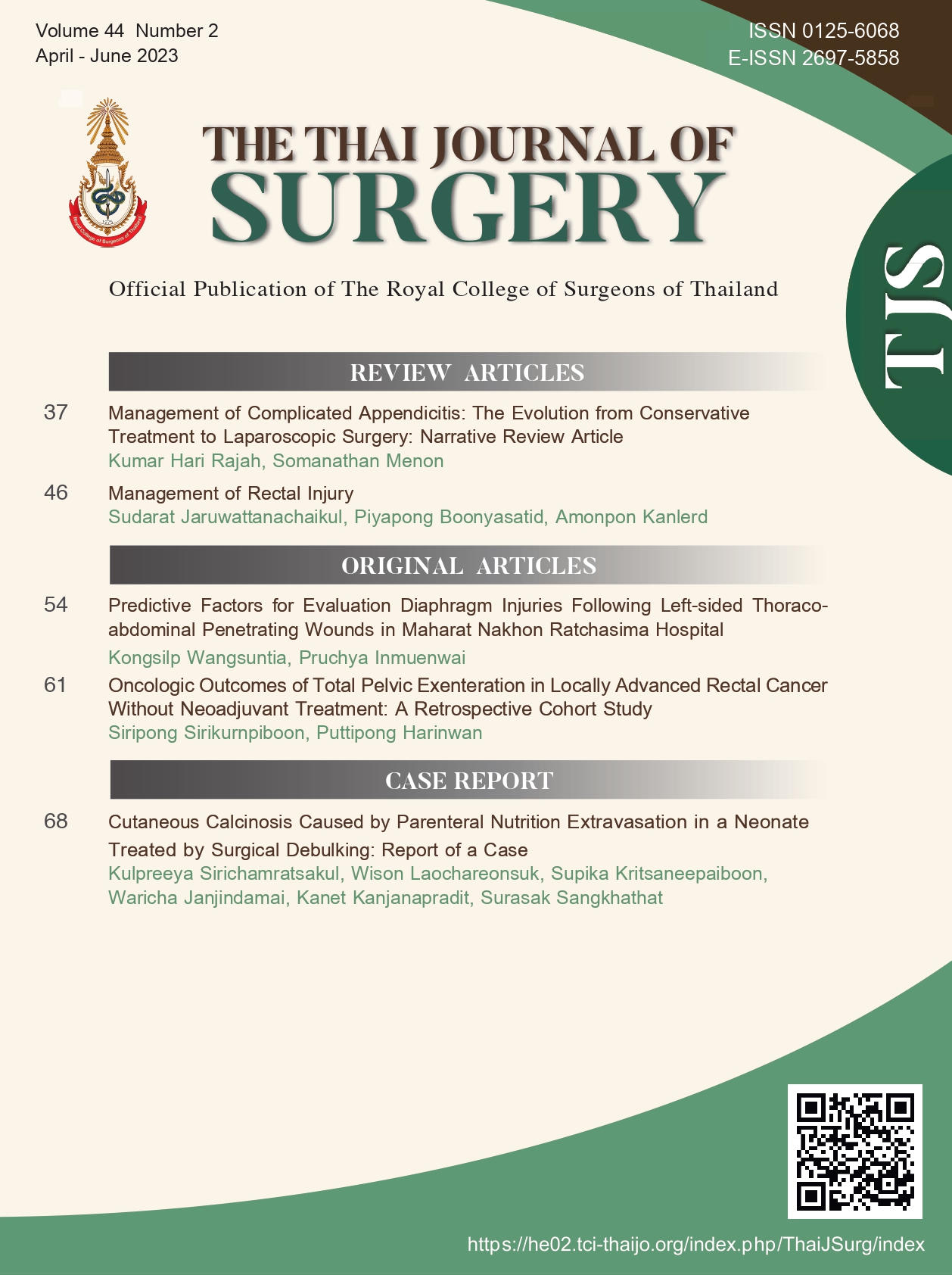Predictive Factors for Evaluation Diaphragm Injuries Following Left-sided Thoraco-abdominal Penetrating Wounds in Maharat Nakhon Ratchasima Hospital
Keywords:
Diagnostic laparoscopy, Penetrating thoracoabdominal injury, Diaphragm injuryAbstract
Background: Diaphragmatic injuries occur in 3% to 5% of patients with penetrating chest traumas. Diagnosing diaphragmatic injuries is difficult based on physical examination and investigation unless obvious signs and symptoms are present. Diagnostic Laparoscopy (DL) is an efficient technique to diagnose and treat diaphragm injuries at the early stage among hemodynamically stable patients. Routine laparotomy for every penetrating thoracoabdominal wound increases the negative laparotomy rate (5% - 40%), leading to more complications, longer hospital stays, and increased costs. Although DL diminishes the negative laparotomy rate, there are some complications. However, laparoscopic intervention is needed to prevent morbidity from unnecessary operations and negative operative findings.
Objectives: The purpose of this study was to determine the predictive factors to evaluate the left diaphragm injuries undergone by Diagnostic Laparoscopy at Maharat Nakhon Ratchasima Hospital (MNRH) and to discuss the outcomes of the findings between patients with diaphragm injuries and patients without diaphragm injuries
Materials and Methods: This Prospective study was conducted among the patients with left-sided thoracoabdominal penetrating wounds admitted to the MNRH from January 1, 2021, to January 31, 2023. The primary outcome of the study was predictive factors of diaphragmatic injuries. The secondary outcome was the length of stays. Stata/SE v11.1 would analyze all data. Chi-square was used to describe predictive factors between the two groups. P value less than 0.05 would be considered the statistical significance.
Results: The total of 52 patients were included. Six individuals (11.53%) had diaphragm injuries. The locations of the injuries below ICS 7th had significant predictive factors of diaphragm injuries, with the odds ratio of 8.73 (95% CI 1.02, 74.95) p = 0.048. The length of stay of the two groups had no significant differences between 5.51 ± 11.19 days in normal and 12.93 ± 26.91 days in diaphragm injuries (95% CI 0.98, 1.05), p = 0.519. There were no significant predictive factors of gender, age, mechanism, CXR, FAST, and multiple sites of injuries.
Conclusion: The locations of injuries below ICS 7th had significant predictive factors of diaphragm injuries. The study limitations were the small population size and the high percentage of unfavorable intraabdominal results. The length of stay of the two groups had no significant differences, similar to other factors.
References
Bagheri R, Tavassoli A, Sadrizadeh A, et al. The role of thoracoscopy in diagnosing hidden diaphragmatic injuries in penetrating thoracoabdominal trauma. Interactive CardioVascular and Thoracic Surgery. 2009;9(2):195–8.
Freeman RK, Al-Dossari G, Hutcheson KA, et al. Indications for using video-assisted thoracoscopic surgery to diagnose diaphragmatic injuries after penetrating chest trauma. The Annals of Thoracic Surgery. 2001;72(2):342–7.
Quinn AC, Sinert R. What is the utility of the Focused Assessment with Sonography in Trauma (FAST) exam in penetrating torso trauma? Injury. 2011;42(5):482–7.
Sharifi A, Kasraianfard A, Chavoshi KA, et al. Value of Ultrasonography in Detection of Diaphragmatic Injuries Following Thoracoabdominal Penetrating Trauma; a Diagnostic Accuracy Study. Arch Acad Emerg Med. 2019;7(1):e45.
Uhlich R, Kerby JD, Bosarge P, et al. Diagnosis of diaphragm injuries using modern 256-slice CT scanners: too early to abandon operative exploration. Trauma Surgery & Acute Care Open. 2018;3(1):e000251.
Como JJ, Bokhari F, Chiu WC, et al. Importance of diagnostic laparoscopy in the assessment of the diaphragm after left thoracoabdominal Abdominal Trauma. Journal of Trauma: Injury, Infection & Critical Care. 2010;68(3):721–33.
Dirican A, Yilmaz M, Unal B, et al. Acute traumatic diaphragmatic ruptures: A retrospective study of 48 cases. Surgery Today. 2011;41(10):1352–6.
Ganie FA, Lone H, Lone GN, et al. Delayed Presentation of Traumatic Diaphragmatic Hernia: a Diagnosis of Suspicion with Increased Morbidity and Mortality. Trauma Monthly. 2013;18(1):12–6.
Kones O, Akarsu C, Dogan H, et al. Is non-operative approach applicable for penetrating injuries of the left thoracoabdominal region? Turkish Journal of Emergency Medicine. 2016;16(1):22–5.
Menegozzo CAM, Damous SHB, Alves PHF, et al. “Pop in a scope”: attempt to decrease the rate of unnecessary nontherapeutic laparotomies in hemodynamically stable patients with thoracoabdominal penetrating injuries. Surgical Endoscopy. 2019;34(1):261–7.
Mcquay N, Britt LD. Laparoscopy in the Evaluation of Penetrating Thoracoabdominal Trauma. The American Surgeon. 2003;69(9):788–91.
McDonald AA, Robinson BRH, Alarcon L, et al. Evaluation and management of traumatic diaphragmatic injuries: A Practice Management Guideline from the Eastern Association for the Surgery of Trauma. Journal of Trauma and Acute Care Surgery. 2018;85(1):198–207.
Murray JA, Demetriades D, Asensio JA, et al. Occult Injuries to the Diaphragm: Prospective Evaluation of Laparoscopy in Penetrating Injuries to the Left Lower Chest. Journal of the American College of Surgeons. 1998;187(6):626–30.
Mjoli M, Oosthuizen G, Clarke D, et al. Laparoscopy in the diagnosis and repair of diaphragmatic injuries in left-sided penetrating thoracoabdominal trauma. Surgical Endoscopy. 2014;29(3):747–52.
Zarour AM, El-Menyar A, Al-Thani H, et al. Presentations and outcomes in patients with traumatic diaphragmatic injury. Journal of Trauma and Acute Care Surgery. 2013;74(6):1392–8.
Powell BS, Magnotti LJ, Schroeppel TJ, et al. Diagnostic laparoscopy for the evaluation of occult diaphragmatic injury following penetrating thoracoabdominal trauma. Injury. 2008;39(5):530-4.
Downloads
Published
How to Cite
Issue
Section
License
Copyright (c) 2023 The Royal College of Surgeons of Thailand

This work is licensed under a Creative Commons Attribution-NonCommercial-NoDerivatives 4.0 International License.
Articles must be contributed solely to The Thai Journal of Surgery and when published become the property of the Royal College of Surgeons of Thailand. The Royal College of Surgeons of Thailand reserves copyright on all published materials and such materials may not be reproduced in any form without the written permission.



